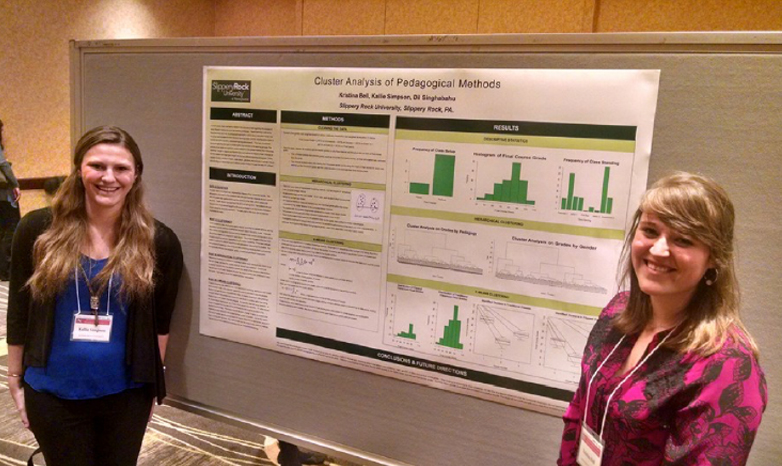SRU undergraduates to present research at national conference

(From left) Kallie Simpson, a senior from Butler, and Kristina Bell, a senior from Prospect, previously presented “Analyzing Underlying Structures of Pedagogical Methods” at the Nebraska Conference for Undergraduate Woman in Mathematics.
March 17, 2016

SLIPPERY ROCK, Pa. - Four Slippery Rock University student research groups - comprised of nine students in all - will present their findings at the 2016 National Conference on Undergraduate Research at the University of North Carolina-Asheville, April 7-9.
"Attending these conferences provides an amazing opportunity for the students," said Dil Singhabahu, assistant professor of mathematics and faculty mentor for one of the research groups. "Not only do they get to present their own work to colleagues and peers, but they get exposure to what others are doing in and outside of their chosen field."
Singhabahu has been working alongside Kristina Bell, a senior from Beaver; Kalene Ireland, a senior from Prospect; and Kallie Simpson, a senior from Butler. They will present "Analyzing Underlying Structures of Pedagogical Methods."
The trio's research is focused on the comparison of the two pedagogical methods (traditional and flipped) used in teaching elementary statistics 1 at SRU. Bell and Simpson used cluster analysis, while Ireland used principal component analysis to compare the grades from the two pedagogical methods.
"These are statistical analysis methods that are challenging for students who are at an undergraduate level," said Singhabahu. "Therefore, exploring data analysis using these methods give (the students) a more in-depth knowledge in statistics and prepares them for the next phase of their journey through higher education."
The trio has presented their work at several other conferences already, including the Nebraska Conference for Undergraduate Women in Mathematics and the Pi Mu Epsilon Mathematics Conference.
Tyler Kuhn, a junior from Pittsburgh, and Conner Smith, a senior from Grove City, will present "Assessing the Attention Networks using fMRI," which represents work the pair are collaborating on with Nancy Day, professor of psychiatry, epidemiology, occupational therapy and clinical and translational science at the University of Pittsburgh.
The research focuses on attention circuits in the brains of 48 individuals that were prenatally exposed to tobacco when compared and contrasted with individuals who were not exposed and what conclusions can be drawn from those comparisons. These attention functions can be modeled using functional magnetic resonance imaging (fMRI) while performing the attention network task.
The purpose of the study is to confirm whether brain activation can be detected using the ANT in the attention networks in a clinical sample of young adults in which changes are expected to be subtle.
The fMRI data was collected from the participants while performing the ANT as part of the 21-year assessment phase of the Maternal Health Practices and Child Development Project. The MHPCD is a longitudinal study of the effects of prenatal drug exposure on growth, behavior and cognitive function. Brain activation associated with each of the attention networks identified in this study will play a critical role in determining whether the ANT can be used to detect subtle differences in brain activation and in understanding the effects of prenatal drug exposure on brain activation and behavioral measures of attention.
Victoria Yeager, a junior from Patton, will present "Examination of Relationship between Mercury Concentration and Great Lakes Region Airshed."
Yeager's research centers on the emissions from coal-fired power plants that pose a risk to the health of humans, ecosystems and wildlife by releasing mercury into the atmosphere. High exposure to mercury can cause a variety of human health issues. Atmospheric winds transport mercury to regions far from the power plants and rainfall transfers it to the ground, a process that consistently contaminates the environment. This long-term study examines the relationship between wind patterns in the Great Lakes Region airshed and elevated levels of mercury in rainfall.
"I have been working with this project for close to two years now, and while I've been lucky enough to present this research at several other conferences, this trip will be my 'last hurrah' with the material," said Yeager.
"My goal in this research was to track the mercury from where it was brought to the ground in rain back to the potential sources. We used various programs to track the mercury, and found that the highest sources of mercury were along the Ohio River Valley, which is not surprising seeing as there are plenty of power plants and sources of mercury along the river."
Richard Zapp, a graduate student from Butler; Kelly Lynch, a junior from Chardon, Ohio and Kaylee Pitzer, a junior from New Wilmington are teaming to present "The Effect of Massage as a Wellness Modality on Productivity in the Workplace."
"Massage therapy treatments are a common wellness modality offered in corporate America to assist in addressing issues such as absenteeism, morale, worker's compensation claims and productivity," said Zapp.
"However, the evidence supporting the positive impact of wellness modalities on these factors is mostly anecdotal. The purpose of this study was to evaluate the effectiveness of wellness modalities including massage and progressive muscle relaxation on productivity."
The trio's study controlled the workload of 42 undergraduate psychology major participants with a simple measure of productivity in which they identified ten matching letters in a letter-search task. Participants worked on the task for twenty minutes.
To best emulate the workplace, participants were then assigned to one of three study conditions:
- A break period in which they receive a 20 minute massage treatment;
- A break period in which they receive a 20 minute muscle relaxation treatment; or
- No break
Following their treatment, participants completed another 20 minutes of work with the number of completed tasks from pre- to post-test being measured.
Participants in the wellness modality break conditions completed significantly more tasks from pre- to post-break compared to the no break group.
"The increase in productivity as a result of receiving a massage or muscle relaxation treatment support the use of wellness modalities by businesses to provide alternative health options for their employees in order to optimize the cost and effectiveness of their programs," Zapp said.
According to Singhabahu, attending research conferences can provide a spark for students to continue their education in terms of attending graduate school down the road.
"It's fun for me to see the excitement in their eyes when they are engaged so deeply with their research," she said. "As an educator, you know when the drive and passion is there for them to want to know more, and often, these types of events provide that catalyst which will provide our next generation of researchers."
MEDIA CONTACT: Robb King | 724.738.2199 | robert.king@sru.edu

